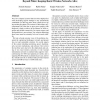Free Online Productivity Tools
i2Speak
i2Symbol
i2OCR
iTex2Img
iWeb2Print
iWeb2Shot
i2Type
iPdf2Split
iPdf2Merge
i2Bopomofo
i2Arabic
i2Style
i2Image
i2PDF
iLatex2Rtf
Sci2ools
NSDI
2008
2008
Beyond Pilots: Keeping Rural Wireless Networks Alive
Very few computer systems that have been deployed in rural developing regions manage to stay operationally sustainable over the long term; most systems do not go beyond the pilot phase. The reasons for this failure vary: components fail often due to poor power quality, fault diagnosis is hard to achieve in the absence of local expertise and reliable connectivity for remote experts, and fault prediction is non-existent. Any solution addressing these issues must be extremely low-cost for rural viability. We take a broad systemic view of the problem, document the operational challenges in detail, and present low-cost and sustainable solutions for several aspects of the system including monitoring, power, backchannels, recovery mechanisms, and software. Our work in the last three years has led to the deployment and scaling of two rural wireless networks: (1) the Aravind telemedicine network in southern India supports videoconferencing for 3000 rural patients per month, and is targeting 50...
Computer Networks | NSDI 2008 | Rural Developing Regions | Rural Viability | Rural Wireless Networks |
| Added | 02 Oct 2010 |
| Updated | 02 Oct 2010 |
| Type | Conference |
| Year | 2008 |
| Where | NSDI |
| Authors | Sonesh Surana, Rabin K. Patra, Sergiu Nedevschi, Manuel Ramos, Lakshminarayanan Subramanian, Yahel Ben-David, Eric A. Brewer |
Comments (0)

